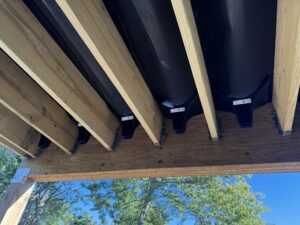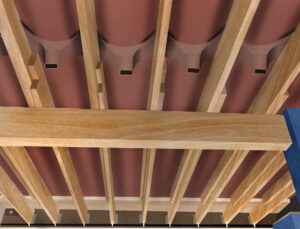I call beams the “backbone” of deck framing. They support joists, which hold the deck boards and the deck’s weight above. When designing your deck, decide whether to use a flush beam or a drop beam.
Read on to understand the differences between the two and how to decide which is better for your deck based on cost, performance, and your design choices.
What Is a Flush Beam?
By “flush,” we mean that the beam and the joists are at the same level. In practice, this means that the joists are fastened to the beam’s sides using joist hangers. Flush beams are the right choice when your home’s entry threshold is low and in a few other scenarios.

Advantages and Disadvantages of Flush Beams
To help you decide whether a flush beam is right for your deck, I’ve listed the most common factors to consider. Not every factor necessarily applies to your situation because every deck project is different. The relevance will depend on your site, design goals, and local building code.
Advantages
- Cleaner appearance because the below-deck structure is less visible than with a drop beam;
- Better fit when vertical space is limited due to ground clearance, door level, or the deck’s low profile; and
- Simpler connections when building angled decks, stair landings, and other features of complex
Disadvantages
- Requires more precise measurements and cuts to ensure joists fit perfectly into accurately spaced joist hangers;
- Requires more time (labor) to fit and fasten joist hangers;
- Complicates some types of stair and guard-rail connections;
- Increases the cost of hardware (joist hangers and other metal connectors);
- Increases the potential for waste due to imprecise cuts by novice DIYers; and
- Relies on metal hangers for joist-to-beam connections, which could be at risk due to improper fastening or long-term exposure to high moisture.
What is a Drop Beam?
“Drop” refers to a beam positioned beneath the joists. Joists sit directly atop the beam. This setup is ideal for cantilevered decks and longer spans. Drop beams are less suitable for limited vertical space, and some prefer less visible beams.
Advantages and Disadvantages of Drop Beams
Use this list of advantages and disadvantages to help decide whether a drop beam meets your preferences, the site conditions, and the construction requirements.
Advantages
- Simpler and faster joist
- Easier to adjust the alignment and length of
- Fewer metal connectors
- Stronger connection and better load distribution because the joists bear on top of the beam, with solid wood-to-wood contact.
- Better performance for longer spans, heavier loads, and
- Less risk of connection failure because joist hangers are
Disadvantages
- More vertical space is required
- More excavation is required if you need to accommodate the beam’s
- More visible, which is less aesthetically pleasing to some
- More susceptible to moisture, rot, and insects if installed close to the
Flush Beam vs Drop Beam: Key Differences
This table highlights the important differences between flush beams and drop beams.
| Feature | Flush Beam | Drop Beam |
| Positioning | Requires precise joist hanger placement to ensure correct alignment | Offers more flexibility because joist lengths are easier to adjust |
| Headroom | Takes up less vertical space; better where headroom is tight | Requires more vertical space; could require excavation or limit design options |
| Joist Connection | Joists connect to the side of the beam using joist hangers | Joists bear directly on top of the beam |
| Aesthetics | Less visible from below; more elegant appearance | Higher visibility from below; more rustic appearance |
| Installation | Metal joist hangers require precise installation; joists require precise cuts | More forgiving of joist placement and imprecise joist cuts |
| Structural Considerations | Easier to connect odd-angled joists | Strong wood-to-wood- connection; longer spans possible |
Choosing Between a Flush Beam and a Drop Beam
Whether to choose a flush beam or a drop beam depends on your deck design priorities, structural requirements, and aesthetics. A flush beam, because it’s installed level with the joists, creates a sleek, modern look and keeps the deck profile low. That’s ideal when the deck doorway is close to grade. However, connecting the joists to the beam requires more precise framing and hanger placement. This could take DIYers extra time.
A drop beam, because it’s positioned below the joists, is simpler to install, structurally stronger, and better suited for supporting heavy loads, spanning greater distances, and creating a cantilever for additional deck space. It might also allow you to leave the joists uncut, saving time and reducing waste. However, the drop beam adds height to the structure, which might raise the deck too much or leave too much space below. As for aesthetics, many people prefer the look of a flush beam, but in some cases, a drop beam’s rustic appearance is the better choice.
Frequently Asked Questions
If you’re still not sure which is the better beam for your new deck, read on.
Which beam type is stronger?
Neither. Beams of the same size, wood type, and span perform the same. However, because the joists bear directly on it, the dropbeam’s connection is stronger.
Can I convert a drop beam to a flush beam?
Yes, but you should have a good reason, as repositioning a beam requires a lot of time and effort.
Are flush beams more expensive to install than drop beams?
Sometimes, but joist hangers don’t cost much, so the difference is negligible.
Do I need to protect flush or drop beams from moisture?
Yes, both beams should be protected, and joist tape is essential. The best method is to apply butyl flashing tape over the top and down the sides. You should also protect the deck joists and apply a penetrating sealant to the end grain at all cuts.
Can drop beams create usable space underneath the deck?
Yes, drop beams carry the joists higher than flush beams do, providing more headroom.
